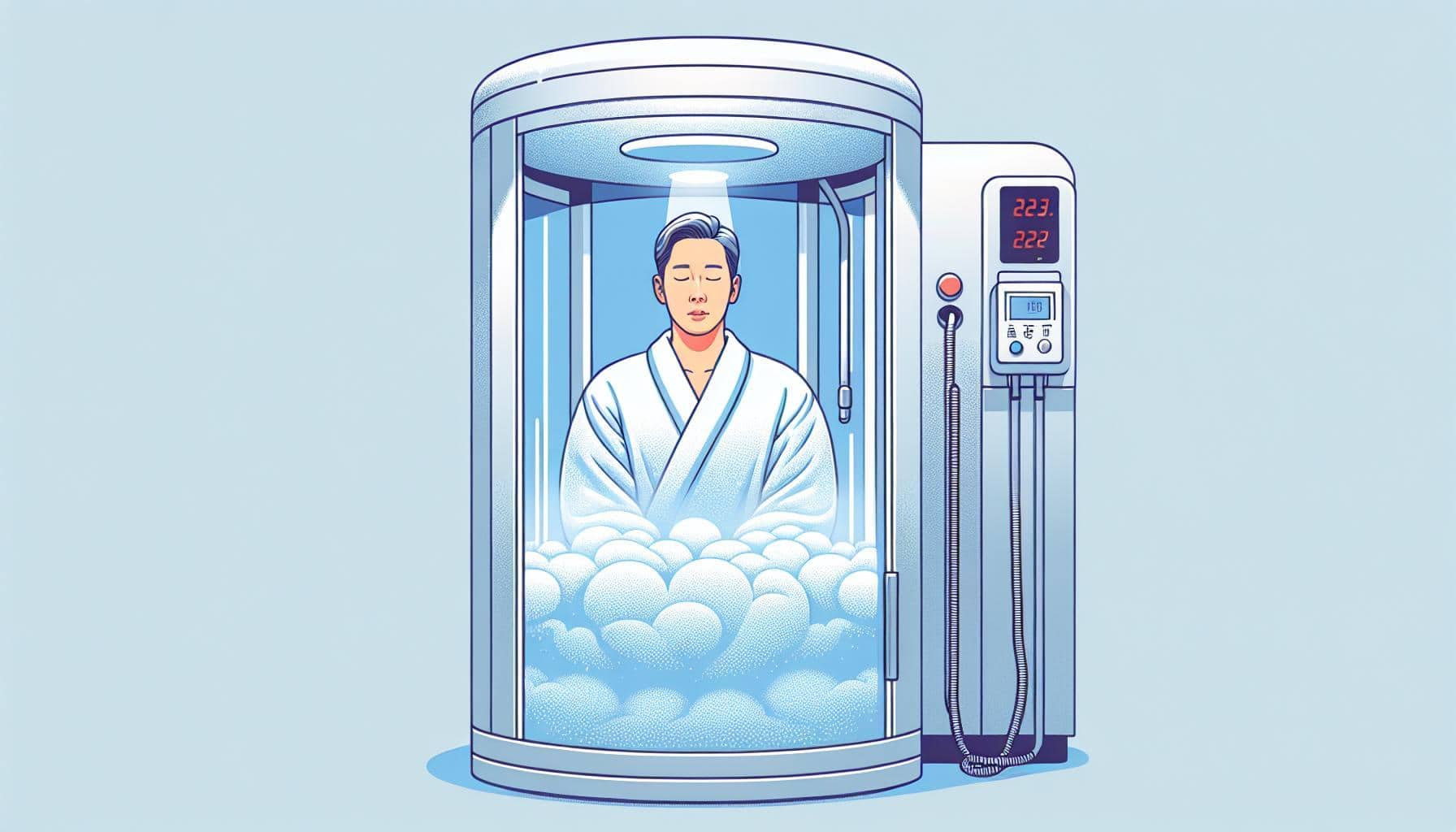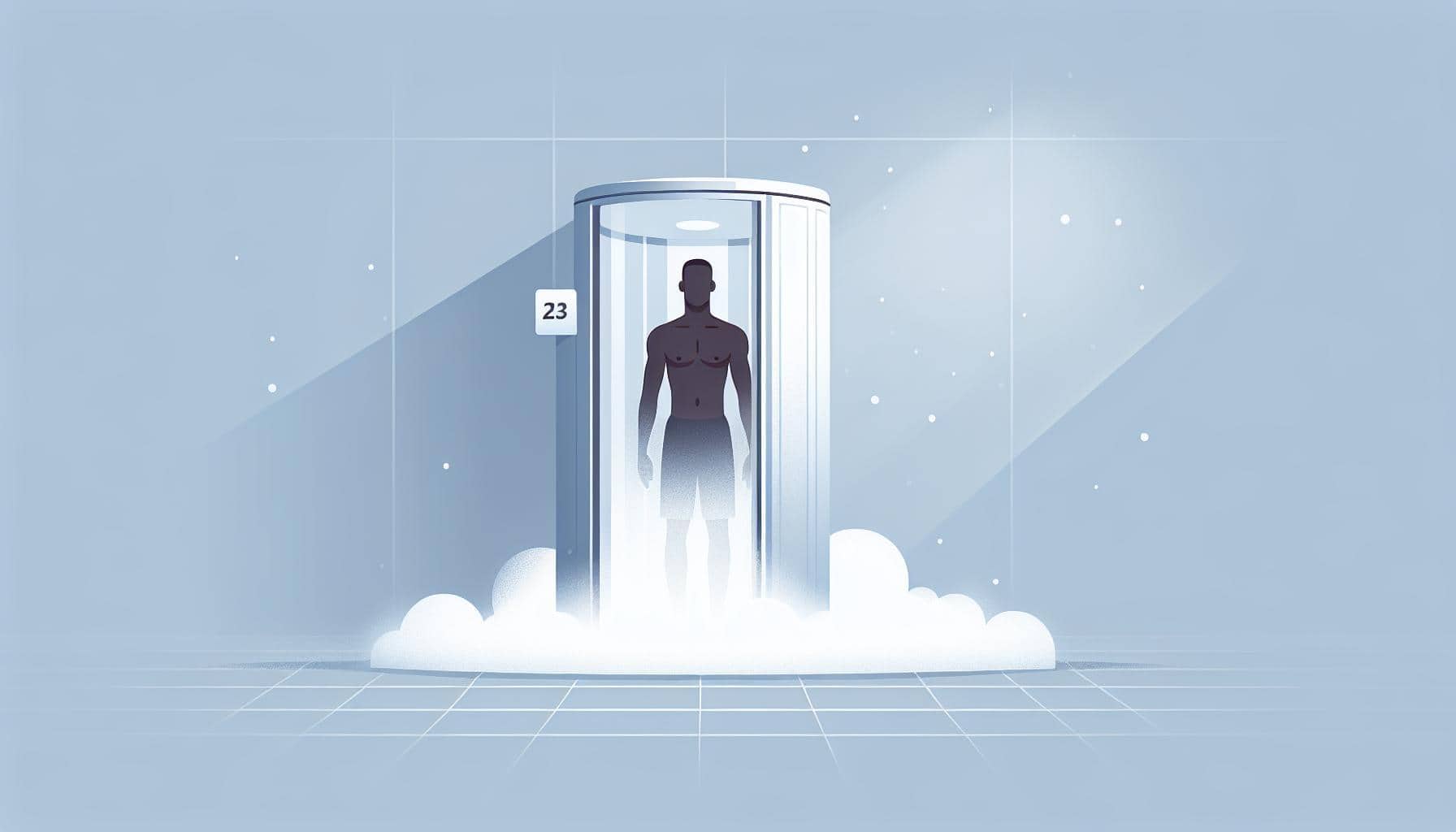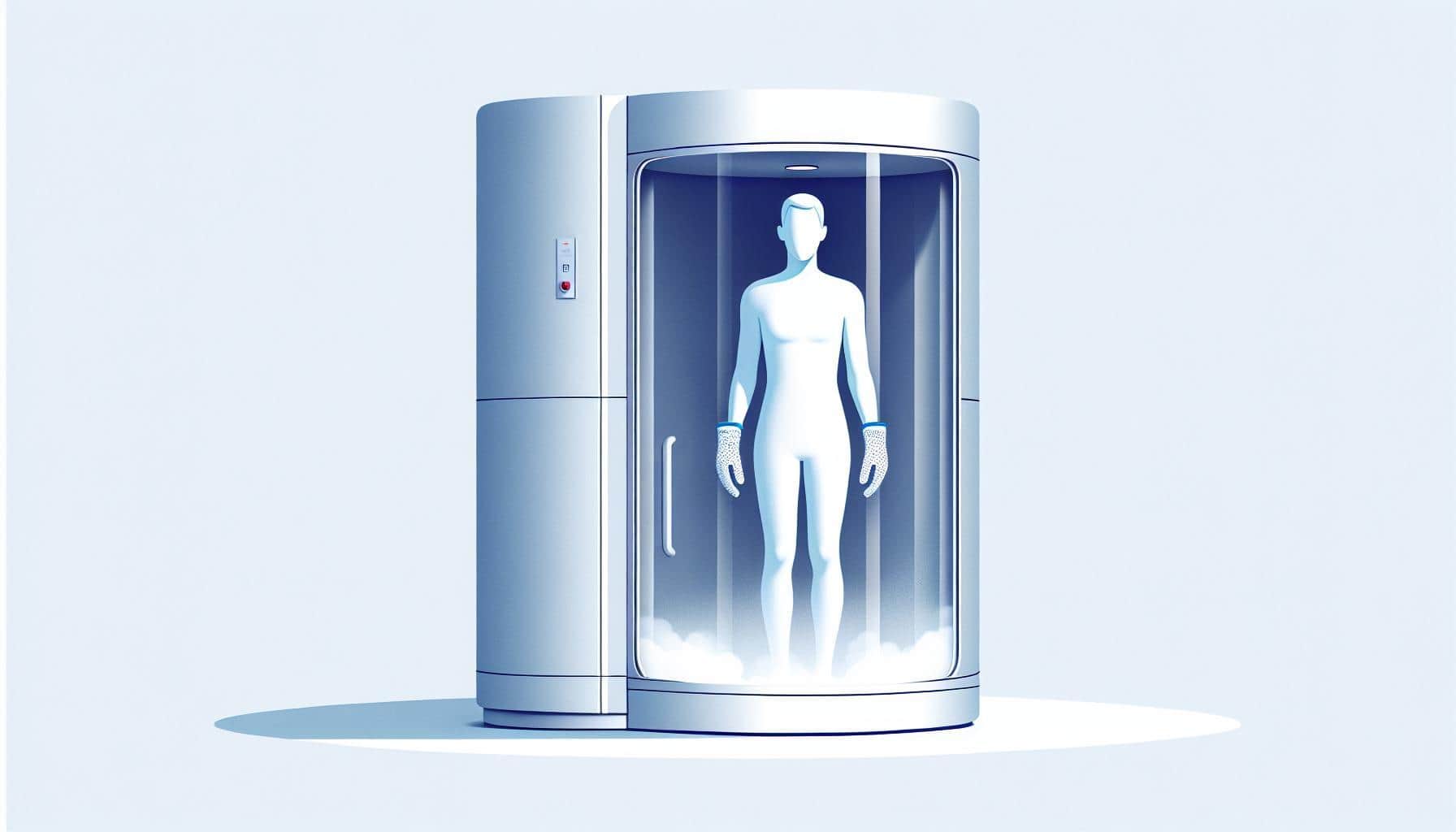Cryotherapy Benefits: Aligning Cold Therapy with Wellness Goals
Have you ever wondered about stepping into a sub-zero chamber as a path to wellness? Cryotherapy, a cold therapy technique where your body is exposed to extremely cold temperatures for a few minutes, might just be the invigorating experience you’re looking for. It’s not just a modern trend; this practice has deep roots and is gaining momentum for its array of potential health benefits.
What is Cryotherapy?
Cryotherapy, often referred to as cold therapy, is a treatment method that utilizes extremely cold temperatures to address various health concerns. You’ve likely heard of its use for muscle recovery and reducing inflammation. The technique is based on the premise that cold temperatures can help to minimize pain and swelling, especially after an injury.
In practice, cryotherapy can be applied in different forms. One popular method is whole-body cryotherapy (WBC), which involves a brief exposure to subzero temperatures in a controlled environment, often at a spa or wellness center. Localized cryotherapy is another modality where treatment is applied to a specific area of the body using methods like ice packs, coolant sprays, or even probes designed to cool the tissues internally.
Whole-body cryotherapy takes the concept of an ice bath to the next level by enveloping your entire body in a chamber with temperatures plummeting as low as -200 degrees Fahrenheit. As daunting as that might sound, sessions typically last between two to four minutes, often enough to trigger your body’s natural defense mechanisms without causing actual frostbite or hypothermia.
The cold is believed to provoke a physiological response from your system, shooting blood to your core to maintain body temperature and then back out to your extremities once you exit the chamber. This process appears to flush out toxins and may increase the circulation of oxygenated blood throughout your body, potentially aiding in recovery and wellness.
While local cryotherapy particularly targets trouble spots, WBC is the catch-all approach, attracting those looking to manage conditions such as rheumatoid arthritis and chronic pain, or seeking benefits like reduced anxiety and support for weight loss efforts. It’s essential to understand that although proponents are many, evidence for nonmedical cryotherapy’s effectiveness remains a hotly debated topic and is not yet approved by the FDA for treatment of medical conditions.
The Science Behind Cryotherapy
 Cryotherapy has piqued the interest of scientists and health enthusiasts alike due to its potential benefits rooted in physiological reactions. When you subject your body to the icy embrace of a cryochamber, the intense cold triggers your body’s survival mechanisms. This sudden drop in temperature is believed to lead to a cascade of biochemical responses. Research points toward a decrease in proinflammatory cytokines, substances associated with inflammation and pain.
Cryotherapy has piqued the interest of scientists and health enthusiasts alike due to its potential benefits rooted in physiological reactions. When you subject your body to the icy embrace of a cryochamber, the intense cold triggers your body’s survival mechanisms. This sudden drop in temperature is believed to lead to a cascade of biochemical responses. Research points toward a decrease in proinflammatory cytokines, substances associated with inflammation and pain.
Additionally, the University of Milan’s School of Medicine review has illuminated the multifaceted impact cryotherapy may have on athletes. Adaptive changes in antioxidant status are noteworthy, considering antioxidants play a crucial role in minimizing oxidative stress caused by intense physical exertion.
Here are a few key biochemical and physiological changes observed:
Change Observed | Impact on Body
|
|---|---|
Reduced Cytokines | Decreased Inflammation |
Antioxidant Adaptation | Enhanced Recovery and Muscle Repair |
Enzymatic Adjustments | Reduced Muscle Damage |
Beyond the inflammation and oxidative stress, cryotherapy is also linked with reduced levels of creatine kinase and lactate dehydrogenase, enzymes indicative of muscle damage and strain. A decrease in these enzymes suggests potential benefits for athletes looking to expedite recovery post intense workouts.
It’s not just your muscles and skin reacting to the cold, but your mental state seems to gain as well. The theory is that the shock from the cold facilitates the release of endorphins, often associated with a mood boost. Just like the feeling you get after a good workout or a brisk cold shower that leaves you invigorated, cryotherapy might replicate this sensation on a higher scale.
The science is still unraveling the full scope of cryotherapy’s influence on physical and mental wellbeing. While studies have shown mixed results, the anecdotal evidence and the physiological changes observed do give credence to some of the claims made by proponents of this chilly therapy. What seems like an Olympic-sized ice bath is, in essence, a trigger for a complex biological symphony aimed at enhancing your body’s resilience and recovery.
Physical Benefits of Cryotherapy
 When exploring the advantages of cryotherapy, you’ll find the physical benefits are particularly compelling. Pain relief is a major aspect, as cryotherapy offers significant alleviation of discomfort, drawing on the age-old practice of applying ice to injuries. Transitioning from a simple ice pack to the immersive cold of whole-body cryotherapy (WBC), the benefits scale up.
When exploring the advantages of cryotherapy, you’ll find the physical benefits are particularly compelling. Pain relief is a major aspect, as cryotherapy offers significant alleviation of discomfort, drawing on the age-old practice of applying ice to injuries. Transitioning from a simple ice pack to the immersive cold of whole-body cryotherapy (WBC), the benefits scale up.
Patients with arthritis or muscle injuries may find cryotherapy especially beneficial. One study shows that those undergoing WBC experience reduced pain perception, less frequent pain episodes, and decreased dependence on pain medication. Moreover, these individuals reported improvements in physical activity range and an overall sense of wellbeing.
Benefit | Impact
|
|---|---|
Pain Perception | Reduction |
Pain Frequency | Decreased episodes |
Analgesic Medication | Lowered usage |
Physical Activity Range | Improved |
Athletes often incorporate cryotherapy into their recovery protocols, experiencing substantial pain relief and muscle repair post-physical strain. It’s not just a reactive measure for injuries; cryotherapy may serve as a preventive strategy, potentially minimizing muscle damage from rigorous training sessions.
In the realm of weight loss, cryotherapy might offer supplementary support. The exposure to cold is thought to burn calories by revving up your metabolism, as your body works harder to maintain homeostasis. Though it shouldn’t replace traditional methods like a balanced diet and regular exercise, cryotherapy could provide an additional edge.
- Muscle Strain Relief
- Athletes report less pain post-injury
- Indicative of reduced muscle damage
Another point of interest is systemic inflammation reduction – a key factor in overall health. High levels of inflammation are associated with various chronic diseases, and cryotherapy’s ability to decrease proinflammatory cytokines offers a promising avenue for mitigating these risks.
To maintain optimal physical condition, it’s essential to integrate various health strategies. Cryotherapy emerges as a modern technique with roots in traditional recovery practices and promising potential for enhancing physical well-being.
Mental Benefits of Cryotherapy
While you’re probably aware of the physical advantages of cryotherapy, it’s time to delve into its impact on your mental well-being. Exposure to extreme cold during a cryotherapy session can lead to a cascade of neurochemical responses in your body, which may have a profound effect on your mood and cognitive functions. In fact, patients often report feelings of increased focus, relaxation, and motivation after undergoing cryotherapy treatments.
The psychology behind cryotherapy is fascinating. The process triggers the release of endorphins, also known as ‘feel-good’ hormones, which can provide a temporary boost in your mood. This hormonal fluctuation plays a significant role in helping alleviate feelings of stress and anxiety. With regular sessions, you might find a noticeable improvement in your mental state, particularly in areas such as:
- Stress reduction
- Enhanced mood stability
- Improved sleep patterns
Another key aspect is how cryotherapy links to the concept of mindfulness. The intense cold forces you to be present and focus on your physical sensations, diverting your attention away from daily stressors. This practice of mindfulness, even if for a brief period during the treatment, can help in strengthening your mental resilience over time.
It’s also important to consider the indirect mental health benefits that come from pain relief and muscle recovery, which cryotherapy provides. Managing chronic pain can be mentally exhausting and can lead to depressive symptoms. By effectively reducing pain and facilitating quicker muscle repair, cryotherapy can aid in lifting some of this burden, allowing you to enjoy a more active and fulfilling lifestyle.
While more research is needed to substantiate the full range of mental health benefits that cryotherapy may offer, many individuals report positive experiences. This emerging therapy could become a complementary approach to traditional mental health treatments, thanks to its potential to enhance one’s mental clarity and overall sense of well-being.
Common Misconceptions About Cryotherapy
When you’re trying to understand cryotherapy, it’s just as essential to address the misconceptions as it is to acknowledge the benefits. Whole-body cryotherapy has gained a reputation as a go-to recovery method, especially with its visibility among the athletic and celebrity communities. However, this visibility has led to some common misunderstandings about its use and efficacy.
First and foremost, many believe that cryotherapy is a Magic Bullet for weight loss. While exposure to cold temperatures does increase metabolism, there’s no solid evidence proving that cryotherapy alone can lead to significant weight loss. It should be considered a supplement to a healthy diet and regular exercise, not a standalone solution.
Another prevalent belief is that cryotherapy chambers are FDA-approved and that they can serve as an alternative to medical treatments. Despite widespread marketing, the FDA has not approved whole-body cryotherapy as a safe or effective method for treating medical conditions or aiding in exercise recovery. Always consult with a healthcare professional before considering cryotherapy as a part of your wellness routine.
The idea that cryotherapy can completely alleviate conditions such as rheumatoid arthritis and chronic pain might lead you astray. Cryotherapy may support pain relief and potentially decrease inflammation, but it’s not a cure-all. It’s important to manage expectations and understand that benefits can vary from person to person, and more research is needed.
It’s common to equate cryotherapy with just its most visual form—whole-body chambers. In reality, the term encompasses a broad spectrum of treatments including Ice Packs, Cold-water Immersion, and sophisticated Continuous Cryotherapy Systems used in sports medicine. Knowing this broad range can help you choose a cryotherapy method that suits your needs and preferences, without falling prey to the misconception that bigger and more elaborate means better.
Recognizing these misconceptions can empower you to make informed decisions about incorporating cryotherapy into your health and wellness practices. Keep in mind that while cryotherapy can offer benefits, its effectiveness and appropriateness for your individual situation should be carefully considered.
Is Cryotherapy Right for You?
 Deciding if cryotherapy suits your health regimen requires personal reflection. Ask yourself: What are your goals with cryotherapy? Are you aiming to manage pain, improve recovery, or enhance overall wellness? Your goals will shape whether cryotherapy’s benefits align with your needs.
Deciding if cryotherapy suits your health regimen requires personal reflection. Ask yourself: What are your goals with cryotherapy? Are you aiming to manage pain, improve recovery, or enhance overall wellness? Your goals will shape whether cryotherapy’s benefits align with your needs.
Before booking that first session, consider the logistics. How many treatment sessions can you commit to? Frequency and consistency are key for noticeable benefits, so align your schedule and budget accordingly. It’s essential to attend multiple sessions for the best results. Remember, it’s not just about the quantity; it’s the regularity of treatment that counts.
However, don’t overlook the possibility of cryotherapy aggravating specific conditions. If you have health issues that worsen with cold exposure, cryotherapy may not be the best choice. Here’s a quick checklist for a pre-cryotherapy safety scan:
- Ensure dry clothing, specifically underwear
- Remove all jewelry to prevent safety hazards
- Guard sensitive body parts with gloves and socks to avoid frostbite
During your cryotherapy session, anticipate a surge of norepinephrine, akin to the boost experienced during physical exercise. This biochemical reaction is one of the ways cryotherapy can bolster your body’s defense against stress. Subsequently, you may notice an increase in inflammation-fighting cellular activities, mirroring the invigorating feeling post-workout.
Cryotherapy also extends its influence to the parasympathetic nervous system, promoting calmness post-stress. Studies have highlighted improvements in heart rate variability, a marker for balanced autonomic function and stress resilience. With your nervous system in better shape, you may find a new sense of equilibrium and relaxation in your daily life.
Keep in mind, cryotherapy encompasses a broad range of treatments. Whether you opt for whole-body cryotherapy or cold-water immersion, each method has unique attributes that could match your preferences. Choose the approach that feels right and fits seamlessly into your wellness journey.
Conclusion
You’ve explored the ins and outs of cryotherapy and now understand how it can potentially enhance your wellness routine. Remember, it’s crucial to align the treatment with your specific needs and be prepared for multiple sessions to truly reap the benefits. Always listen to your body and ensure you’re not exacerbating any pre-existing conditions. With a variety of cryotherapy options available, you’re empowered to select the one that resonates with your health objectives. Embrace the cold and let your body experience the invigorating effects of this modern health practice.
Frequently Asked Questions
How often should you do cryotherapy?
For optimal results, it’s typically recommended to undergo cryotherapy one to five times a week. Each session should last no more than three minutes, with the frequency and duration depending on your personal wellness goals and tolerance.
What happens to your body after cryotherapy?
Post-cryotherapy, you’ll likely feel invigorated due to the rush of endorphins. Once your core temperature starts to normalize, your blood vessels dilate, which can make you feel energetic and refreshed as a result of the increased blood flow.
How quickly do you see results from cryotherapy?
Immediate effects are common, but for sustained results, a minimum of 10 sessions over two to three weeks is often recommended. Benefits tend to be cumulative, intensifying with regular treatments.
What are 3 benefits of cryotherapy?
Three notable benefits of cryotherapy are the potential for faster muscle recovery, a reduction in chronic pain and inflammation, and a short-term boost in mood due to the release of endorphins.
Does 1 session of cryotherapy work?
Yes, a single cryotherapy session can yield benefits. Most individuals experience a surge of endorphins and adrenaline, leading to a heightened sense of focus and rejuvenation immediately after treatment.

